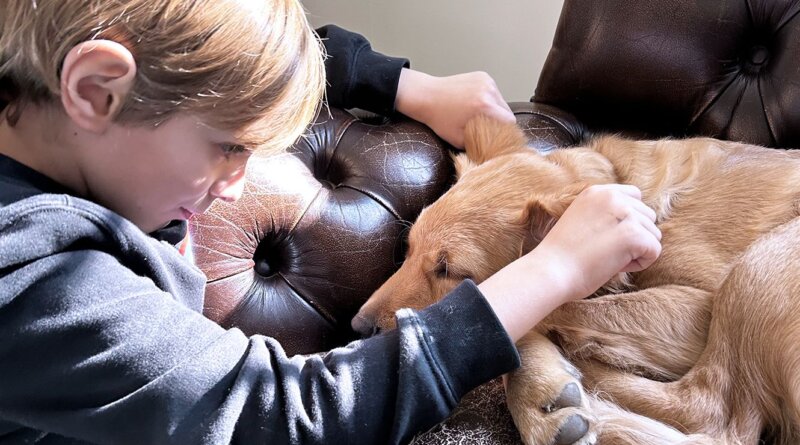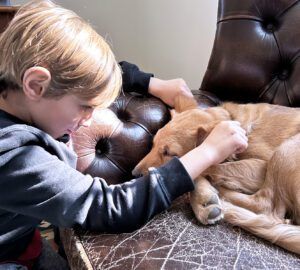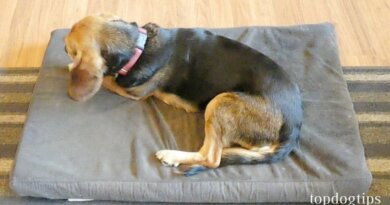Get Your Puppy Used to Body Handling
If I ask 10 new puppy owners what they plan to focus on at first, none of them will answer “body handling.” That’s a shame, because one of the kindest things you can do for your puppy – and for your future benefit! – is to help him feel calm about being handled in all the various ways he will experience in his future life with you.
Typically, when a puppy needs a complicated harness put on, muddy paws wiped off, or an ear cleaned out, we humans tend to just hold him still and do it. We don’t bother to slow down and wonder how exactly this new experience feels to the puppy. If we did, we’d realize that this unusual handling – something that does not happen naturally on Planet Dog – may make our puppy anywhere from uncomfortable to downright frightened.
Think I’m being overly sensitive? Think the puppy just has to cope? Well, sure. The little puppy does just have to cope, because we can manhandle him at this point. But someday he’ll be an adult, with a strong jaw and teeth capable of damage. That’s when it becomes crystal clear that it would have been smart to teach him that all of this handling is nothing to be anxious or defensive about.
I recommend making a plan to teach your puppy to enjoy human touch as much as possible. By intentionally creating a strongly positive association with body handling, you’ll make your own life easier while setting the stage for less stressful (and cheaper!) handling at the vet or the groomer. The first step is to learn how and where he naturally likes to be touched.
What Kind of Touch Does Your Puppy Like?
Have you ever gotten a massage that you hated? Maybe it was too hard, too soft, too fast, too variable, or too much in one spot. We all have our preferences – and so do our dogs. But people often miss dogs’ subtle reactions and continue petting even as a dog flinches away. Alas, that dog may be learning she has to advocate more clearly, perhaps with her teeth, later on.
Let’s avoid that! Instead, look hard for those body language clues, and use that information to adjust your style. Is the puppy leaning into the touch, or looking away and pulling out of reach? As a starting point, keep in mind that most dogs prefer slow, consistent strokes with gentle pressure. (Without realizing this, many people seem to go for frenzied, hard patting, or light feathery touches – both of which seem to bug many dogs.) As for location, many dogs lean into butt scratches but shift away from head pats.
The bottom line: Become a connoisseur of your puppy’s favorite way of being touched. Help guide other family members and friends in her orbit: “Oh, hey, you know what she really likes? Watch this.” Soon you have a puppy trotting happily over to people rather than scooting away from outreached hands. This is huge, folks. Take time with this wonderful step that can pay off in a friendly puppy who looks forward to engagement.
This consent-based approach to petting goes for picking up, too. It is hard to resist picking up a cute puppy all the time, but try, especially at first. Some puppies sadly learn to flee from their family members (or growl at them) because they know they’ll soon be trapped in somebody’s arms! Take the time to let the pup choose and soon you may have a pup who does indeed love being picked up. (See “How to Pick Up a Puppy,” May 2022.)
Gently, Gradually Handle Feet, Ears, Mouth
Once you’ve learned how to create a great petting experience for your particular puppy, it’s time to slowly push the envelope. Obviously, vets and groomers need good access to a dog’s ears, eyes, mouth, and feet – all of which are often no-go zones at first from a dog’s perspective. You can work to change that. Here’s how to begin:
- Create a daily practice of finding your pup when he’s sleepy and calm – maybe it’s while you’re watching TV at night – and giving the kind of massage session you’ve learned that he enjoys.
- As he relaxes, experiment with gently touching the ears for just a second . . . then quickly go back to regular massage. If there is little or no reaction, go ahead and increase that ear duration to a few seconds. Still OK? Then go ahead and incorporate ear massage into your regular daily massage session.
- Slowly, as the days and weeks go on, repeat this process for mouth/teeth, eye area, and feet. Don’t get ahead of yourself; if you try to make too much “progress,” you may ruin your lovely massage tradition! Ideally you can get to a place where the daily massage is a time to deepen the lesson that it’s actually quite fine to be touched in all of those tricky places.
- Once things are going that well, experiment with being even more invasive. Rather than just touching or massaging, go ahead and look in that ear for a second, or lift up that gum to examine the teeth for a moment. Whenever you take a step forward like that, quickly go back to calming massage before pup even has a chance to think about it. This is a classic go-slow-to-go-fast situation. If you rush into doing a full pretend exam, you may set back the all-important level of trust.
Trouble? Add Treats & Verbal Narration
Above I’ve outlined how to proceed if your pup calmly accepts each new level of handling. But what if he doesn’t? Most dogs have at least one fairly sensitive spot. What if, when you lightly touch a finger to their paw, they yank it away every time?
That’s when I bring in treats for some counter conditioning. I personally don’t start with food because sometimes it creates a level of excitement that interferes with progress. However, sometimes I clearly need some help. Cheese to the rescue!
Actually, cheese and Mr. Rogers. When dogs are nervous about things, I rely on the “Mr. Rogers Hack” from the Family Dog Mediation course presented by trainer Kim Brophey, CPDT-KA, CDBC. Since dogs have the receptive verbal ability of a human toddler, it is incredibly effective to use our words to help them better anticipate what’s next. So in this case I grab a tiny bite of cheddar, and say, “It’s OK, I’m just going to touch your paw.” The second after the smallest of touches, I pop the cheddar in the puppy’s mouth. At first the pup has no idea what those words mean, but soon they come to convey that a delicious treat will follow an innocuous paw touch. I repeat that until – ideally – I have a puppy who can’t wait to come running when I say I want to touch his paw. It becomes a game.
Getting Comfortable with Grooming
We humans are pretty obsessed with having perfectly clean dogs. Your dog will thank you to remember that that is not actually a dog thing. Eighty percent of the dogs in the world are free-roaming, not pets, and in that natural state they don’t get bathed, brushed, and clipped. And yet we somehow expect our dogs to immediately and fully tolerate brushes, clippers, and lengthy baths with strongly scented shampoo.
That’s why part of your body handling exercises must include the equipment and locations involved in whatever grooming process will be a part of your dog’s life. Show your puppy the brush/clipper/dremel with Mr. Rogers’ help: “Oh, it’s OK! That’s just a brush!” followed by a nibble of turkey. A few days later, once puppy eagerly approaches the tool thanks to that positive association, experiment with a light touch from the brush, more narration, and a treat. Just remember: Great dog training is often boring because it involves so much repetition at a slow pace. Accepting that truth pays off in the end!
If you’re going to be using a groomer, find one who talks your ear off about how important the first visit is. If she suggests starting with a “fun visit” before an actual appointment, be thrilled rather than annoyed. A groomer who understands it’s critical to help the puppy feel calm is a keeper. (The wrong groomer can do all sorts of harm in terms of setting back your puppy’s trust regarding human handling.)
Prepare Your Pup for Vet Visits
Now it’s time to play doctor with your puppy! Once you’ve gotten your pup into the swing of intentional body handling that goes beyond simple cuddles, it’s time to work a one-minute pretend veterinary appointment into your days. Using the same incremental, short-duration process (alternating challenging new handling with well-liked kinds of touch, treats, or play), mimic a vet appointment. Do a quick narrated restraint – “It’s OK! I’m just going to hold you for a sec!” – followed by a happy congratulations and a toy or a treat. Then a little ear check, a pretend vaccination, a glance at a tooth, and then check out with a big celebration. Repeat, repeat, repeat until your puppy knows the words that you can then use at her next appointment about checking ears, checking teeth, etc.
Note that you can go well beyond this into the wonderful practice of cooperative care, but that’s beyond the scope of today’s topic. For now, simply make a point of remembering to give your pup the chance to experience all of these unusual ways of being handled to the point that they no longer feel unusual.
#1 Rule is Maintain Trust
My worry in writing this piece is that well-meaning folks will leap into this effort with too much gusto. They’ll jump into the pretend vet visit on Day #1, restraining their pup and poking into ears – which will result in a pup who’s conflicted about their own person’s outstretched hands. Please hold back! Go slowly. I want your puppy to always think “Yay!” at your approach.
The first priority for every puppy owner should be establishing the fact that they are their puppy’s rock, their trusted guide here on perplexing Planet Human. Happily, there is a way to do these body handling exercises that truly supports that goal. If you go slowly enough, make a point of making each session 95% beloved touch style, and just 5% new experimenting sandwiched in there, in the end you are simply building trust and connection with every session.





